Datebook: Feminist performance, intersecting art worlds, the photographs of Sally Mann
A night of performance art, art by outliers and the avant-garde, and the life’s work of a Southern photographer. Here are seven exhibitions and events to check out in the coming week:
“En Cuatro Patas: Nao Bustamante, Gina Osterloh and Dorian Wood,” at the Broad Museum. It is the final installation of the feminist, Latinx performance series organized by Bustamante, who is a noted performance artist herself. The evening will include a series of actions around the building and the public plaza that will consist of sculpting the body, an artist’s play with shadows and another’s exploration of voice. Thursday at 8:30 p.m. 221 S. Grand Ave., downtown Los Angeles, thebroad.org.
“Outliers and American Vanguard Art,” at the Los Angeles County Museum of Art. Like most other areas of culture, art has long been preoccupied with issues of credential: of those who are trained in the academy and those who are not — though credential has never been a guarantee of producing art that is transcendent. This wide-ranging exhibition, organized in collaboration with the National Gallery of Art, presents more than 250 works by more than 80 artists that chronicles moments in time in which the self-taught intersected with the avant-garde. This includes work by Henry Darger, Cindy Sherman, Kara Walker and Martín Ramirez, among many others. Opens Sunday and runs through March 17. 5905 Wilshire Blvd., Mid-Wilshire, Los Angeles, lacma.org.

Lee Mullican, “The Marble Drawings, 1966-1970,” at Marc Selwyn Fine Art. Mullican was a member of the Dynaton group, an influential trio of artists from the ’50s interested in surrealism, automatism and mysticism. The group was short-lived, but some of its precepts lived on in his work as an independent artist, such as his so-called marble drawings, which used repetition and pattern to create works that channel the spiritual. Opens Saturday at 6 p.m. and runs through Feb. 2. 9953 S. Santa Monica Blvd., Beverly Hills, marcselwynfineart.com.
Sally Mann, “A Thousand Crossings,” at the Getty Museum. Over more than four decades, the photographer has chronicled the lives of her children, her husband, the Virginia landscape and its troubled legacy of slavery and Jim Crow. This exhibition, organized by the National Gallery of Art in Washington, brings together 110 black and white images, some produced as tintypes, and many of which have never before been seen. Altogether, a look into histories both personal and political. Opens Friday and runs through Feb. 10. 1200 Getty Center Dr., Brentwood, Los Angeles, getty.edu.
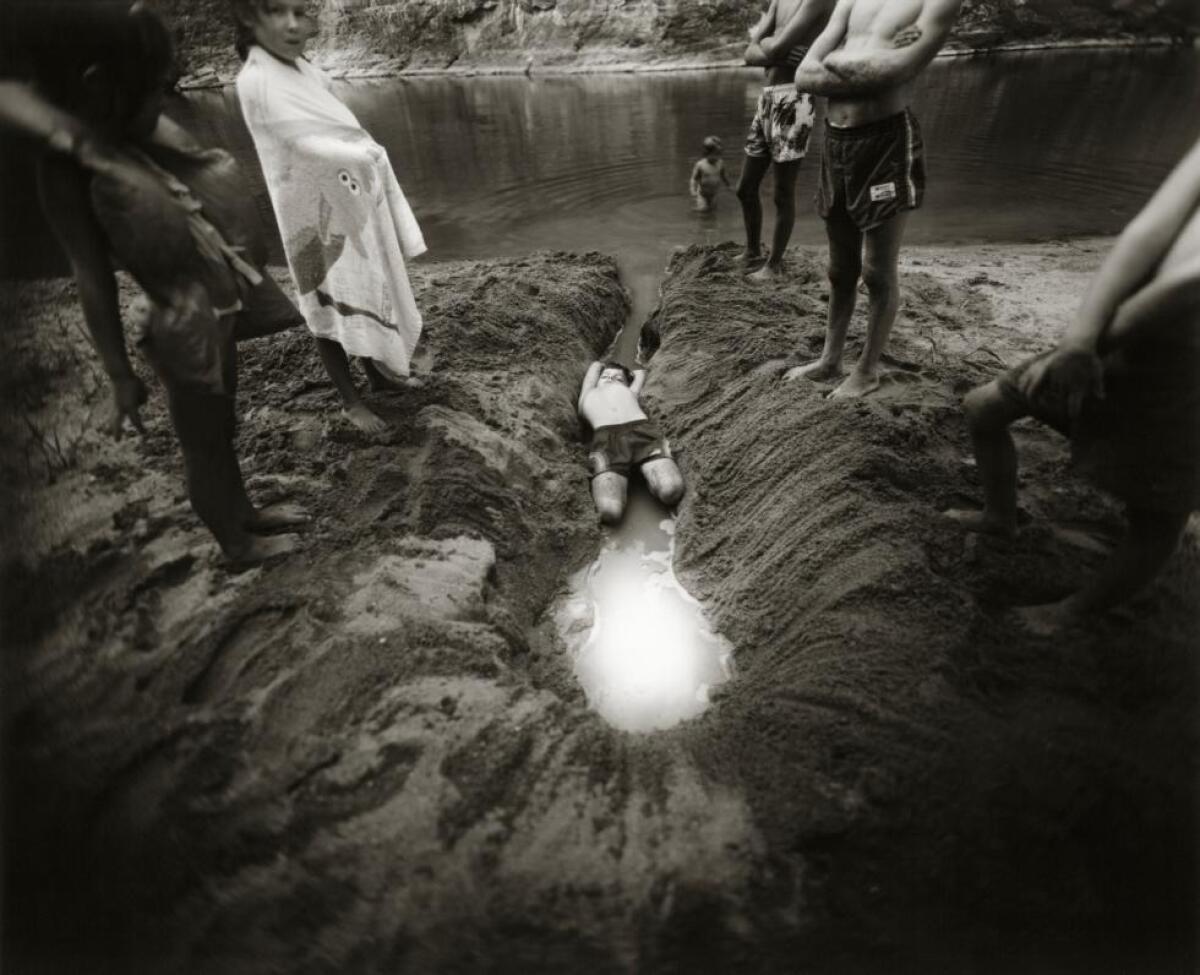
Alison O’Daniel, “The Sea, The Stars, The Landscape,” at Pollution.tv Studios. O’Daniel is presenting an 18-minute short of her longer film “The Tuba Thieves,” which is about sound and loss of hearing. The piece is being staged as a projection by Los Angeles Nomadic Division and will be accompanied by artist Helga Fassonaki, alumnae of the Centennial High School Marching Band and trumpet player Omar Corona (who has a role in the film). Admission is free but an RSVP is required. Sunday at 5 p.m. 3239 Union Pacific Ave., Los Angeles, nomadicdivision.org.
Bridget Riley, “Painting Now,” at Sprüth Magers. For almost six decades, the renowned optical artist has toyed with perception in two dimensions by using shape, color and form to create hallucinatory canvases (a counterpart to L.A.’s light and space movement). This current show features one of her earliest pointillist works dating back to 1960 with more recent stripe and disk paintings. Expect some good vibrations. Opens Thursday at 6 p.m. and runs through Jan. 26. 5900 Wilshire Blvd., Mid-Wilshire, Los Angeles, spruethmagers.com.
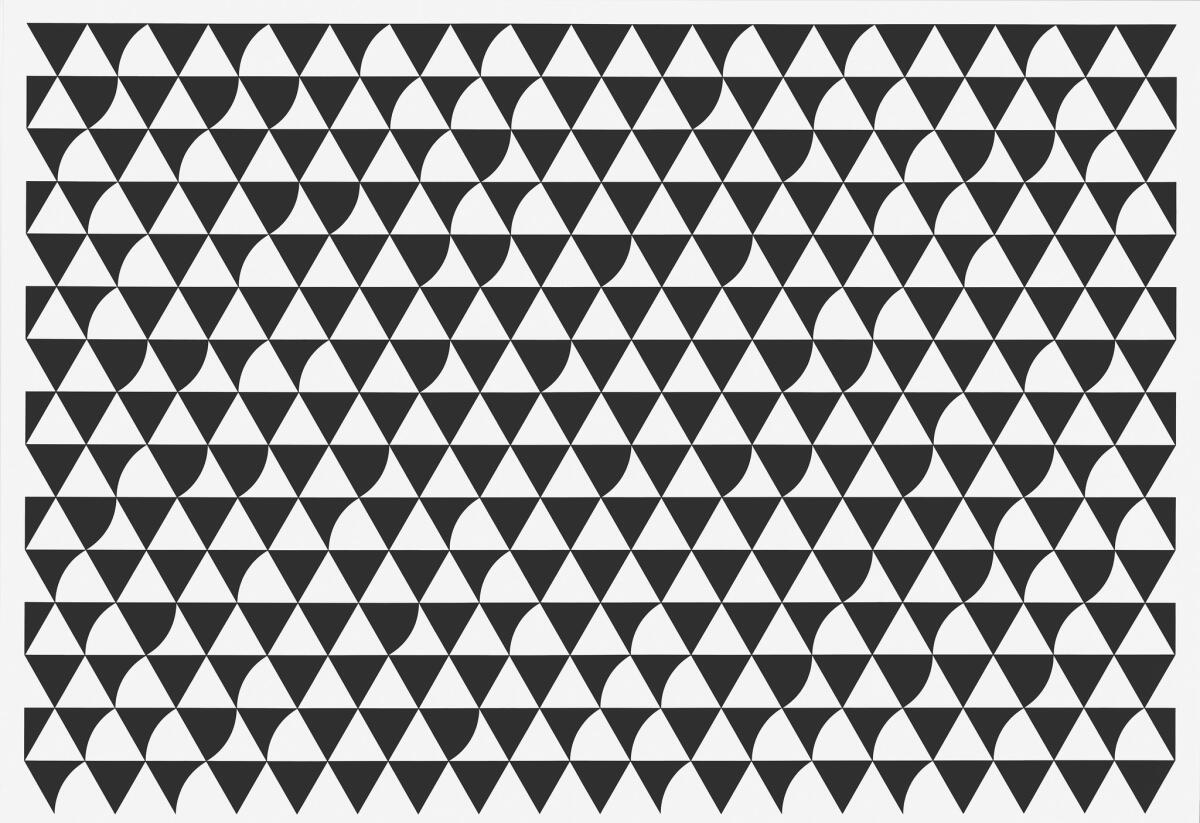
Victoria May and Lisa Diane Wedgeworth, “Woman / Woman,” at Louis Stern Fine Arts. A two-woman show brings together works by artists whose pieces employ texture and surface to create canvases that go beyond the two-dimensional. In her work, Wedgeworth channels elements of the astronomical, while May’s art is bound in the earthier materials (from chiffon to alpaca fur) that she brings together in collaged wall installations. Opens Sunday at 5 p.m. and runs through January 12. 9002 Melrose Ave., West Hollywood, louissternfinearts.com.
“Elegant Science,” at Unit 5. A group show is focused on work by artists who engage science and technology in their work. This includes historic imagery, by the likes of 19th century photographer Eadward Muybridge, known for his groundbreaking images of a horse in mid-gallop, and more contemporary work by the likes of Trevor Paglen, who has created records of national security infrastructure. Other artists featured include Man Ray, Thomas Struth and Kerry Tribe. The space is a new collaboration between two L.A. galleries: Praz-Delavallade and 1301PE. Opens Saturday at 6 p.m. and runs through Dec. 2. 6150 Wilshire Blvd., Carthay, Los Angeles, 1301pe.com.
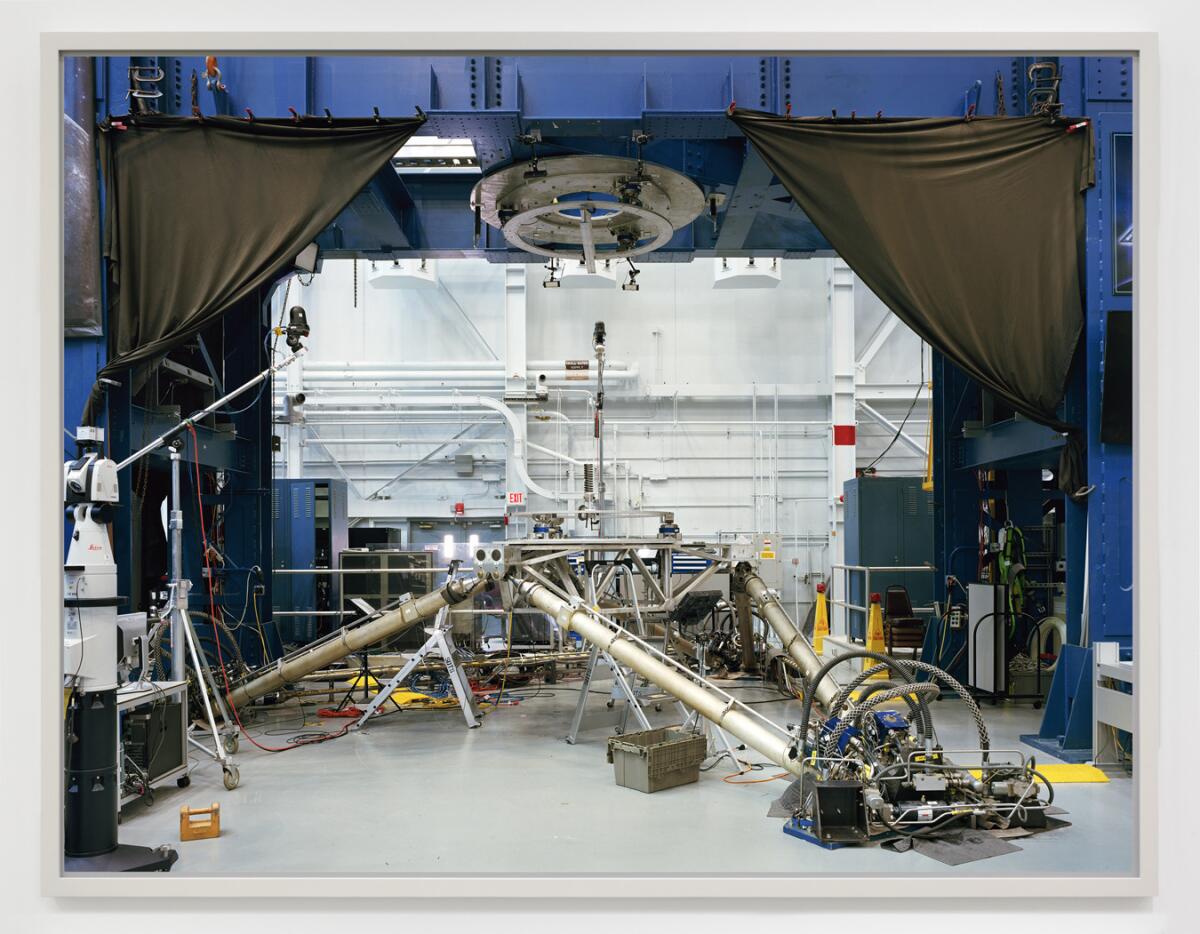
ONGOING
“Anatomy of Oil,” at Gas Gallery. Los Angeles had stretches that were once covered in oil extraction infrastructure such as pumpjacks, a few of which still dot the city as vestige. This group show looks at the history of oil production in our city and the ways in which it has shaped the landscape. Through Nov. 24. The truck will be parked at Odd Ark L.A. (7101 N. Figueroa St., Unit E), among other locations. Check the website for the full schedule, gas.gallery.
Jo Ann Callis, “Now and Then,” at Rose Gallery. Callis is known for her constructed photographic scenes, often rendering fragments of bodies at odd and twisted angles, in ways that harken to playful and moody sexual scenarios or their immediate aftermath. Through Nov. 24. Bergamot Station, 2525 Michigan Ave., No. D4, Santa Monica, rosegallery.net.
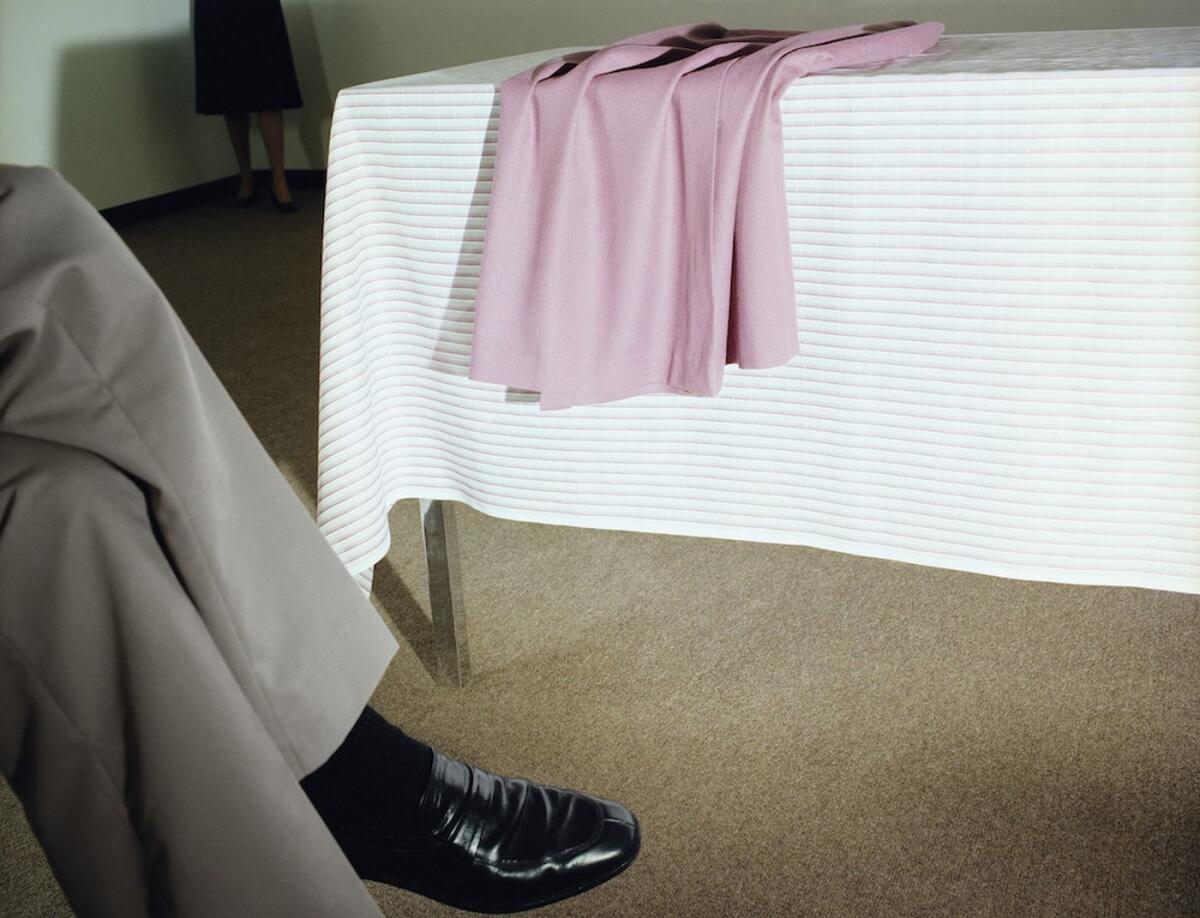
“Wireframes: The Visualization of Architecture,” at the A+D Museum. An exhibition gathers work by 30 artists and architects that examine the ways in which buildings are presented in renderings. Through Nov. 25. 900 E. 4th St., downtown Los Angeles, aplusd.org.
Porfirio Gutiérrez and Ricardo Palavecino, “Exodo,” at the Palm Springs Art Museum. A pop-up and workshop series features Gutiérrez’s weavings and Palavecino’s video and photography from Oaxaca, offering a window into contemporary Zapotec life in the southern Mexican region. Through Nov. 30. 101 Museum Drive, Palm Springs, psmuseum.org.
Sadie Barnette, “Black Sky,” at Charlie James Gallery. The multimedia artist’s works often engage social and historical issues, such as the ways in which the FBI investigated the Black Panthers (of which her father was a member). This solo exhibition, her second at the gallery, features the collaged pieces that employ her father’s FBI files as source material as well as an immersive installation that riffs on the nature of domestic space. Through Dec. 1. 969 Chung King Road, Chinatown, Los Angeles, cjamesgallery.com.

“IndigNATION: Political Cartoons by Jim Carrey, 2016-2018,” at Maccarone. The actor, it turns out, is quite handy with a pen. And in reaction to our political situation, he has produced a series of political cartoons that, in scathing ways, pick apart the foibles of the Trump administration. Through Dec. 1. 300 S. Mission Rd., Boyle Heights, Los Angeles, maccarone.org.
“All that Glitters: Life at the Renaissance Court,” at the Getty Museum. No group in history has quite done bling like the Renaissance elite: there was gleaming armor, rich textiles, monarchs draped in brocaded everything — not to mention architecture studded with gleaming stained glass and other luxuriant details. This exhibition gathers illuminated manuscripts, paintings, drawings, household articles and accessories that convey the richness of life in a Renaissance court. Get ready for some serious shine! Through Dec. 2. 1200 Getty Center Dr., Brentwood, Los Angeles, getty.edu.
Fred Tomaselli at the Oceanside Museum of Art. The New York-based painter is known for creating hallucinatory canvases that explore cosmic and internal journeys — deeply collaged paintings that often employ materials such as psychotropic drugs (cannabis leaves and pills) amid layers of resin and paint. Through Dec. 2. 704 Pier View Way, Oceanside, oma-online.org.
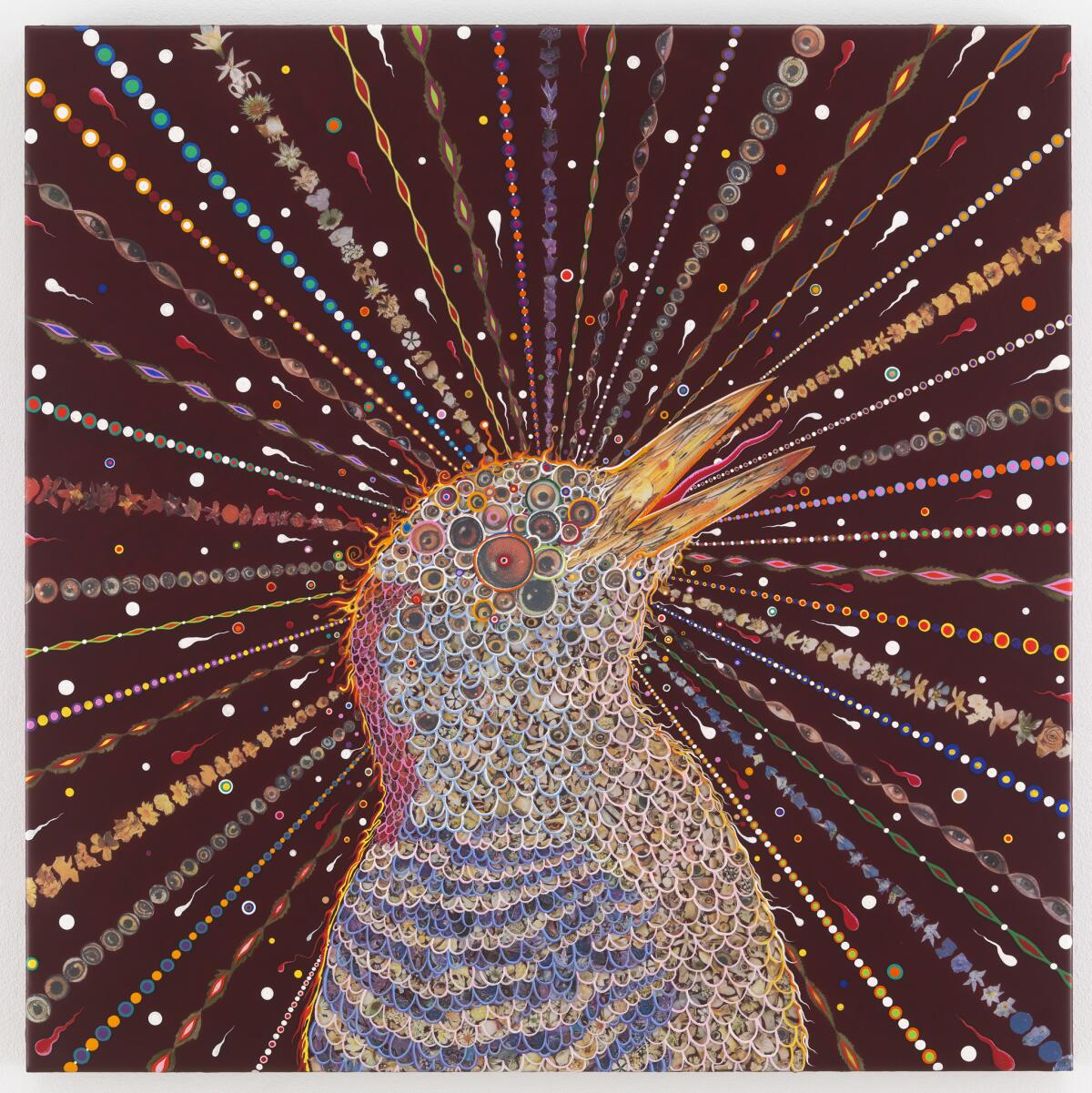
Justin Brice Guariglia, “Earth Works: Mapping the Anthropocene,” at the Fisher Museum of Art and, “Earth Works,” at the Natural History Museum. In large-scale works that combine photography and layers of paint, Guariglia tracks the ways in which humans are affecting the planet — the age known as the anthropocene. The artist flew with NASA to survey melting glaciers in Greenland, and some of the works in the show cover the state of our precarious ice caps. But Guariglia also looks at the ways in which humans have shaped the surface of the planet in other ways, such as mining and agriculture. The show is spread across two institutions: the Fisher Museum of Art at USC and the Natural History Museum, which lies right across the street. Through Dec. 8. Fisher Museum of Art, 823 W. Exposition Blvd., University Park, fisher.usc.edu and nhm.org.
Joaquin Boz, “Bruselas y Nueva York,” and George Rouy, “Smothered Awake,” at Steve Turner. The gallery has a pair of shows on view. This includes paintings by the Buenos Aires-based Boz that were created during artistic sojourns in Brussels and New York. In a separate gallery, Turner is showing paintings by Rouy, an English artist whose large-scale canvases feature bodies contorted and compressed. Through Dec. 8. 6830 Santa Monica Blvd., Hollywood, steveturner.la.
Janet Sternburg, “Limbus,” at the Fisher Museum of Art. Sternburg creates deeply layered photographs that aren’t so much one image as an intersection of images: reflections, mirrors, objects captured as seen through other objects. Through Dec. 8. 823 W. Exposition Blvd., University Park, fisher.usc.edu.
“Judy Dater: Only Human” at the Laband Art Gallery. Over 50 years, Dater, who is from Los Angeles, has created work that challenges the clichéd stereotypes of women and the female body in portraiture, as well as beautifully composed images that fuse landscape and the body. The exhibition, organized by San Francisco’s De Young Museum, will feature 50 of the artist’s master works from throughout her influential career. Through Dec. 8. 1 LMU Dr., cfa.lmu.edu.
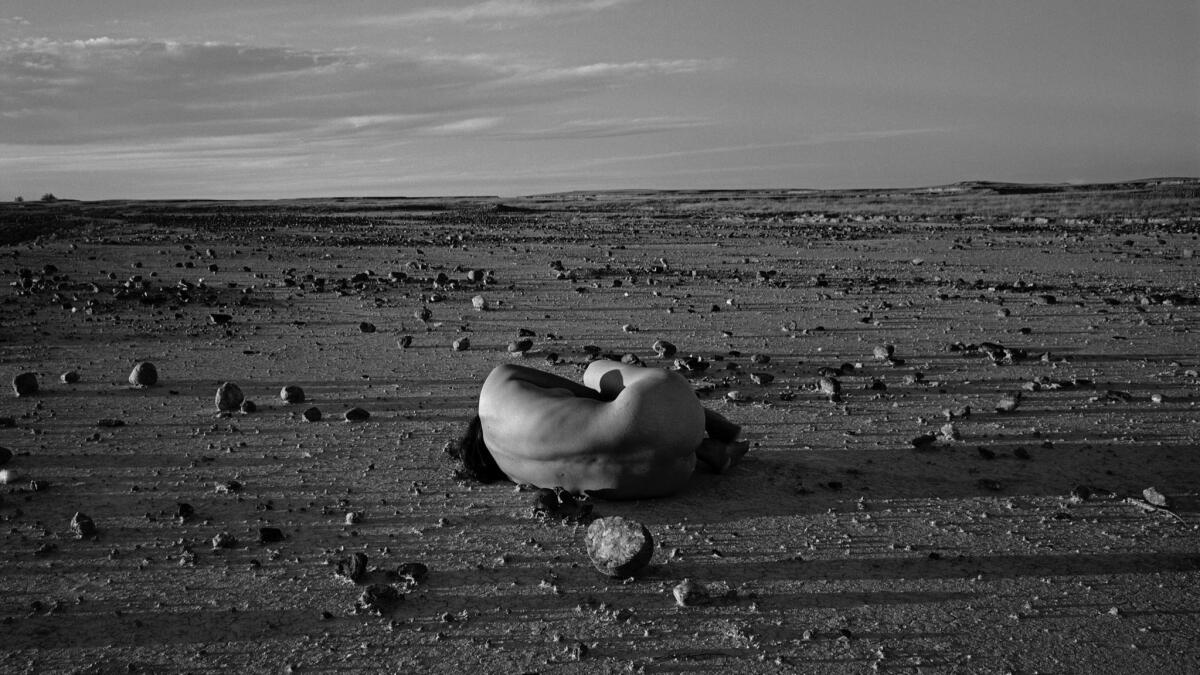
“A Handful of Dust: From the Cosmic to the Domestic,” at the California Museum of Photography. Dust permeates the air around us. Dust will bury the cities we live in when we are gone. A group exhibition at UC Riverside brings together images produced over the last century that capture the various aspects of dust. The images are both benign and destructive, featuring the natural world, but also aspects of urban decay. Artists featured include John Divola, Man Ray, Gerhard Richter and Shomei Tomatsu. Through Dec. 9. UC Riverside Artsblock, 3824 Main St., Riverside, artsblock.ucr.edu.
Sou Fujimoto, “Futures of the Future,” at Japan House. An exhibition gathers more than 100 models and large-scale photographs of work by the influential Japanese architect. Fujimoto has designed libraries, pavilions and Tokyo’s iconic House NA, a delicately rendered dwelling that consists of a series of staggered glass volumes that architecture critic Oliver Wainwright once described as “the closest thing to a glass and steel treehouse.” Through Dec. 12. 6801 Hollywood Blvd., Hollywood, japanhouse.jp.
Peter Williams, “River of Styx,” at Luis De Jesus Los Angeles. In a series of bright, pointillist paintings, Williams explores the divide between the world of the living and the dead while also wrestling with some very current topics in U.S. society, including police violence, corruption and the systems that favor some over others. Through Dec. 15. 2685 S. La Cienega Blvd., Culver City, luisdejesus.com.
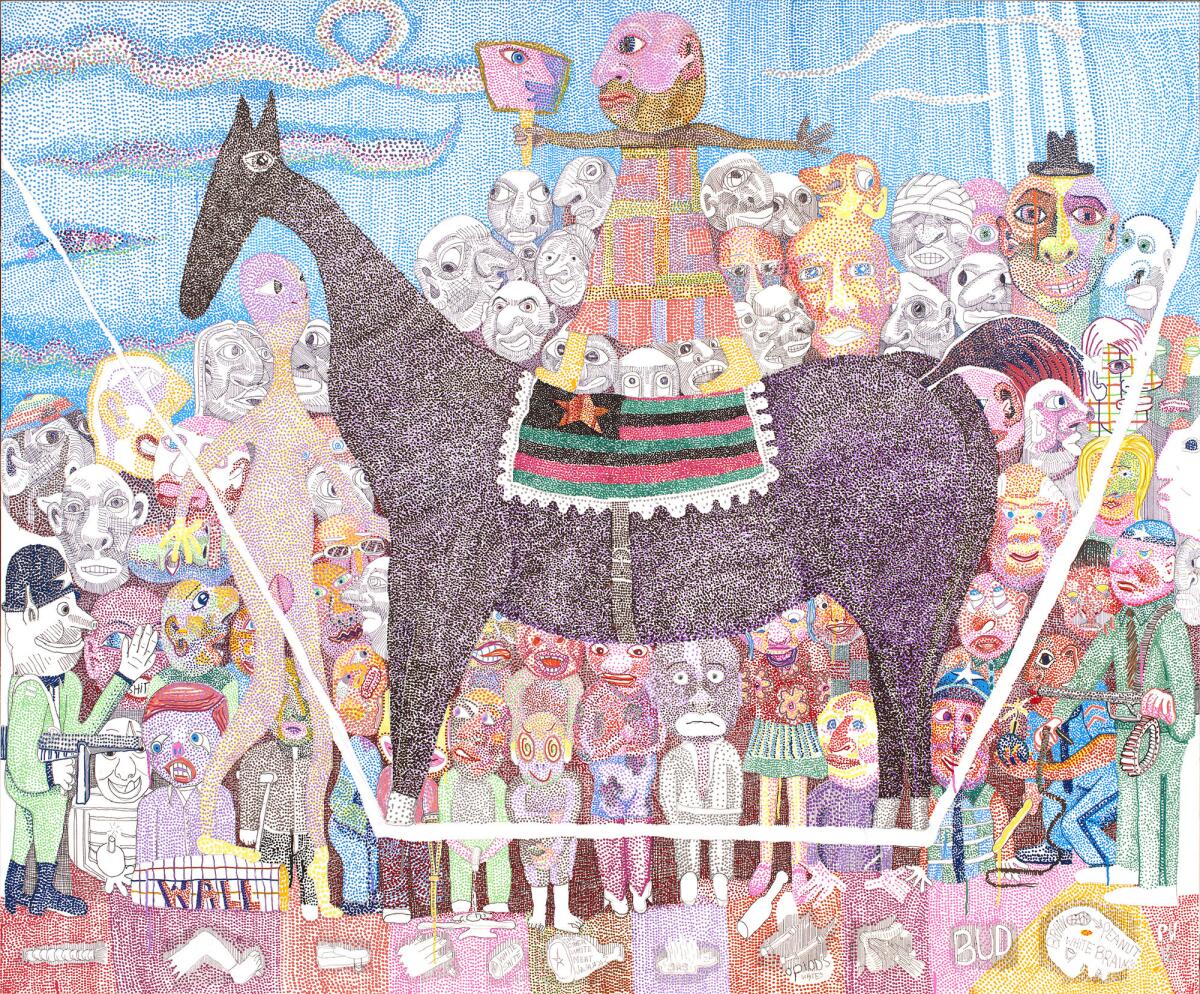
Olafur Eliasson, “The Speed of Your Attention,” at Tanya Bonakdar. The high-profile New York gallery now has a Los Angeles space, and to kick off the fall season, it is going with a high-profile artist: Eliasson, who is known for his large-scale architectural work that plays on the nature of experience and physical space. His current series of works explores the idea of the speed at which attention moves — inspired by a technique deployed in dance in which choreography is generated by improvised contact between two people. Through Dec. 15. 1010 N. Highland Ave., Hollywood, tanyabonakdargallery.com.
Betye Saar, “Something Blue,” and “Holding Up 1/2 the Sky,” at Roberts Projects. The gallery has two shows on view. The first features the work of Saar, the renowned assemblage artist, who will be showing a series of pieces produced over a period of 3½ decades, from 1983 to 2018, that all employ the color blue in some fashion — a tone that, for the artist, channels elements of magic, purity, love and protection against the Evil Eye. Inspired by Saar’s adept use of materials, curator jill moniz brings together work by female sculptors in a separate gallery. This sounds like one not to miss. Through Dec. 15. 5801 Washington Blvd., Culver City, robertsprojectsla.com.
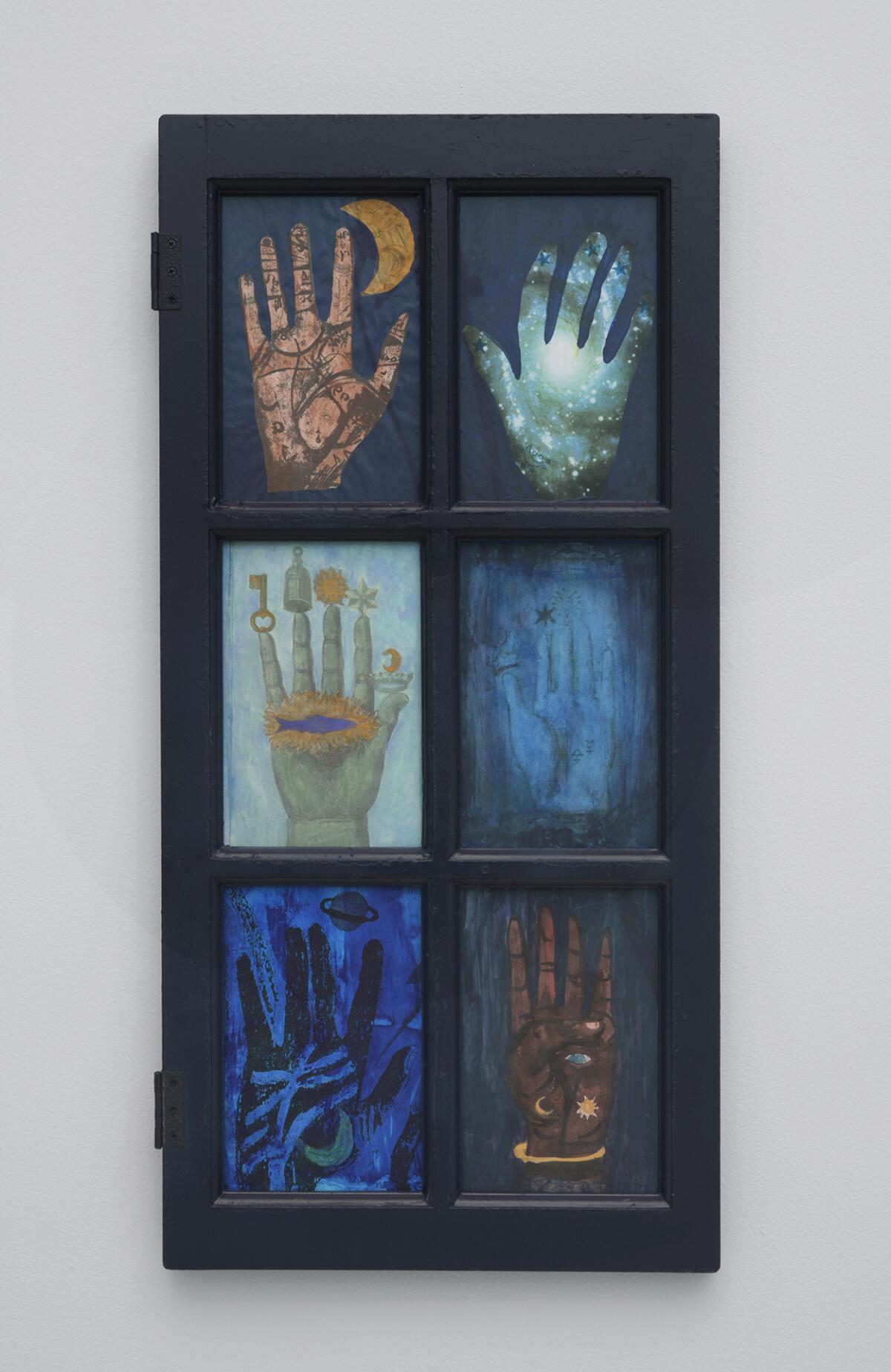
Ricky Swallow, “Shoulders” and Ivan Morley, “Olvera Street,” at David Kordanksy Gallery. The gallery has a couple of new shows on view. The first, by Swallow, features new, larger-scale work by the artist known for rendering humble materials such as rope and rattan cane in long-lasting bronze. Morley, in the meantime, has a series of works inspired by objects found on Olvera Street, including leather and painted glass — works that also reflect on Los Angeles history dating back to the era of the Spanish colony. Through Dec. 15. 5130 Edgewood Pl., Mid-Wilshire, Los Angeles, davidkordanskygallery.com.
Mary Reid Kelley & Patrick Kelley, “America Rides the Breakfast Table,” at Susanne Vielmetter Los Angeles Projects. The latest show by the multimedia duo centers around a recent video project, “The Body of the Sturgeon,” which depicts a submarine crew in the Pacific Theater during the final days of World War II. Each line of the script is taken from a line in “The Song of Hiawatha,” the epic poem by Henry Wadsworth Longfellow that helped cement the idea of the noble savage; the artists then scrambled Longfellow’s words and rendered them anew. Also on view will be sculptures, paintings and photographic lightboxes connected with the project. Through Dec. 15. 6006 Washington Blvd., Culver City, vielmetter.com.

Trudy Benson, “Cuts, Paints,” at Team Bungalow. On the surface, Benson’s paintings might seem like simple geometric abstractions. But take a closer look and they reveal deep layers: spray-painted squares, thick layers of paint, sections that are taped off and then peeled back to reveal the colors underneath. These play with color as much as texture. Through Dec. 16. 306 Windward Ave., Venice, teamgal.com.
“Divided Brain,” at LAVA Projects. A group show of 15 Los Angeles artists features work that unites qualities of perfection with those of an unbridled wildness. Artists on view will include Jim Shaw, Michael Alvarez, Robyn O’Neil and Winnie Truong. Through Dec. 16. 2417 W. Valley Blvd., Alhambra, lavaporjects.com.
“Akunnittinni: Akinngait Family Portrait,” at the Armory Center for the Arts. A stirring group show chronicles art by three generations of one Inuit family: Pitseolak Ashoona (1904-1983), her daughter Napachie Pootoogook (1938-2002) and granddaughter Annie Pootoogook (1969-2016), which captures elements of daily life and the shifting landscape beyond. Also on view is a show of paintings by Marta Chaffee that chronicles the California landscape. Through Dec. 16.145 N. Raymond Ave., Pasadena, armoryarts.org.

“Reuven Israel: In Four Acts,” at Shulamit Nazarian. In his second solo show with the gallery, the artist is presenting a series of modular sculptures — constructed out of cut oak and brass hardware — that can be presented in different configurations. Each piece will change four times during the course of the show. Through Dec. 20. 616 N. La Brea Ave., Hancock Park, Los Angeles, shulamitnazarian.com.
Marcia Hafif, “A Place Apart,” at Pomona College Museum of Art. The minimalist painter, whose work explored color, its range and its histories, has a show of more than 100 works on view at the museum. In addition to her paintings, for which she was best known, the show also explores Hafif’s drawing practice. Through Dec. 22. 330 N. College Ave., Claremont, pomona.edu/museum.
Chung Sang-hwa and Shin Sung-hy, at Blum & Poe. A two-man show features rare and historic works by two key Korean painters of the 20th century: Chung, who is connected with the minimalist Dansaekhwa movement of the ’70s, and Shin, who is known for toying with the two-dimensional nature of painting, producing hyper-realistic representations of jute on jute canvas. Through Dec. 22. 2727 S. La Cienega Blvd., Culver City, blumandpoe.com.
Tavares Strachan, “Invisibles,” at Regen Projects. Strachan has a major installation on view as part of the recently opened Carnegie International in Pittsburgh — and it connects with the show he has put together at Regen: pages of a reimagined Encyclopedia Britannica that contain the historical figures left out by the authors of the original encyclopedia, who have historically been white and male. It’s an incisive look at the nature and power of knowledge and how it is controlled. Through Dec. 22. 6750 Santa Monica Blvd, Hollywood, regenprojects.com.
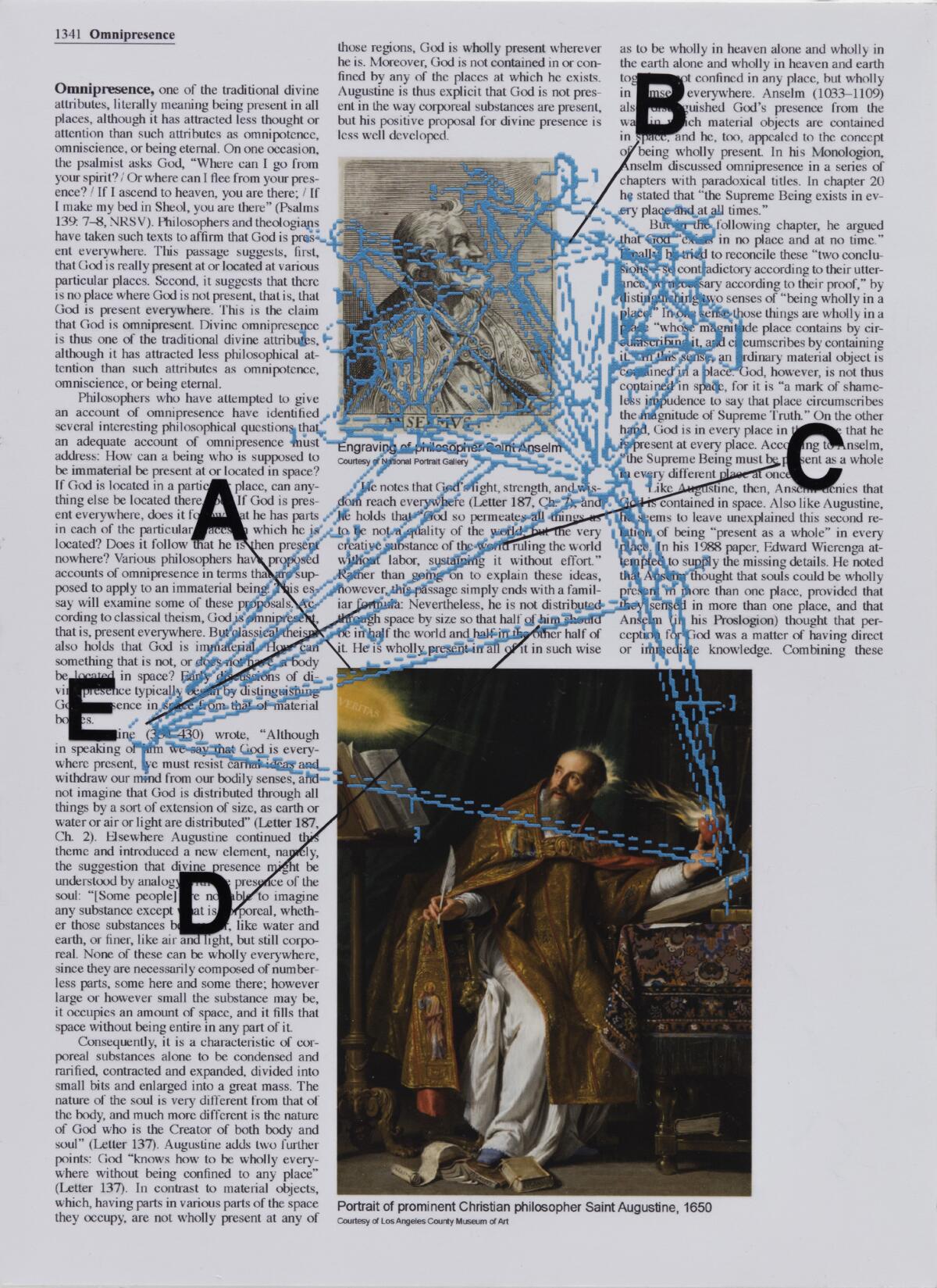
Yunhee Min & Peter Tolkin, “Red Carpet in C,” at UCR Arts. Inspired by the writings of Johann Wolfgang von Goethe, who described music as “liquid architecture” and architecture as “frozen music,” Min and Tolkin have created an installation that fills the UCR Arts atrium with an undulating form constructed out of 150-foot bands of fabric and more than 17,000 colored paper tubes. Through Dec. 29. UC Riverside, 3824 and 3834 Main St., Riverside, ucrarts.ucr.edu.
Judithe Hernández, “A Dream Is the Shadow of Something Real,” at the Museum of Latin American Art. Hernández is known for her work as a painter and muralist; the museum is showcasing more than two dozen of her recent works on paper: dream-like scenes that feature women and wildlife against slightly surreal landscapes. Also on view will be a number of Hernández’s early sketchbooks, as well as the museum’s recent acquisition, her canvas “Les Demoiselles d’Barrio,” a feminist take on Picasso’s 1907 “Les Demoiselles d’Avignon.” Through Dec. 30. 628 Alamitos Ave., Long Beach, molaa.org.
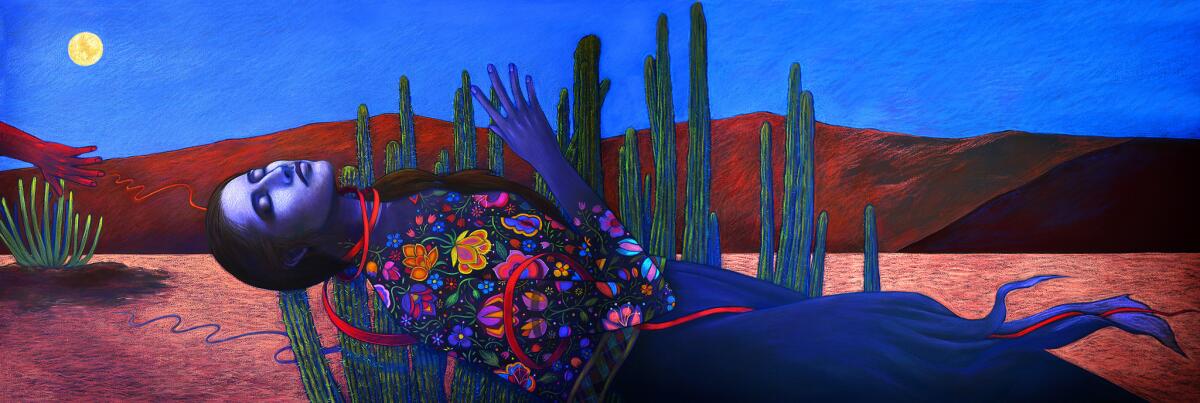
“Stone to Stains: The Drawings of Victor Hugo” at the Hammer Museum. Hugo is best known as the novelist and playwright who produced the iconic literary works “Les Misérables” and “The Hunchback of Notre Dame.” He was also an accomplished artist. And this exhibition showcases some of the thousands of rarely seen ink and wash drawings he left behind upon his death in 1885. Expect to see the world — architecture, landscapes and roiling seas — through the eyes of this singular figure. Through Dec. 30. 10899 Wilshire Blvd., Westwood, Los Angeles, hammer.ucla.edu.
“Striking the Iron: The Art of African Blacksmiths,” at the Fowler Museum. A sprawling exhibition of more than 225 objects will examine the virtuosity of African blacksmiths of the 19th and 20th centuries, who forged iron objects — such as blades, elements of sculpture and musical instruments — that were as aesthetically pleasing as they were, in many cases, functional. Many objects, drawn from the Fowler’s collection, are connected with rituals and the powers of the natural world. This is the debut of this traveling exhibition, which will then go on to the National Museum of African Art in Washington. Through Dec. 30. 308 Charles E. Young Drive N., Westwood, Los Angeles, fowler.ucla.edu.
“Gary Simmons: Fade to Black,” at the California African American Museum. In a lobby installation — one that takes full advantage of its size and scale — Simmons pays tribute to forgotten African American actors and films. On a black background, the L.A. artist features the titles and names of films and individuals important to the early days of Hollywood history, but forgotten over time. Through Dec. 31. 600 State Drive, Exposition Park, Los Angeles, caamuseum.org.
“Childhood Left at the Station: A Tribute to the Children of the Kindertransport,” at the Los Angeles Museum of the Holocaust. At the start of World War II, a non-denominational group supported by Jewish, Quaker and other groups called the Movement for the Care of Children From Germany organized to rescue children persecuted by the Nazi authorities in Germany. This exhibition brings together objects from 10 of the estimated 10,000 children who were rescued from Germany — many of whom never saw their parents again. Through Dec. 31. 100 The Grove Drive, Fairfax, Los Angeles, lamoth.org.
“Sperm Cult,” at LAXART. A group exhibition takes on the generative, myth-making power of sex, all inspired by a book project by Elijah Burgher and Richard Hawkins that explored sex in connection with ritual and the occult. Through Jan. 5. 7000 Santa Monica Blvd., Hollywood, laxart.org.

Sarah Steinberg, “In the Woods,” at Lois Lambert Gallery. Memory has a way of fashioning reality into something else. Steinberg explores this phenomenon in a series of works that dwell on a Canadian landscape that has been dear to her, but which aren’t literal depictions of that place. Instead, her work is more about sensations, shapes and familiar architecture.Through Jan. 5. Bergamot Station, 2525 Michigan Ave., Santa Monica, loislambertgallery.com.
“Here,” at the Los Angeles Municipal Art Gallery. A group exhibition examines the physical and geographical boundaries that define Los Angeles and its environs — and the ways in which those boundaries can shift and change. This will include painting, video and installation by a wide range of L.A.-area artists, including Mario Ybarra Jr., Henry Taylor, Sandy Rodriguez and Fran Siegel. Through Jan. 6. 4800 Hollywood Blvd., Hollywood, lamag.org.
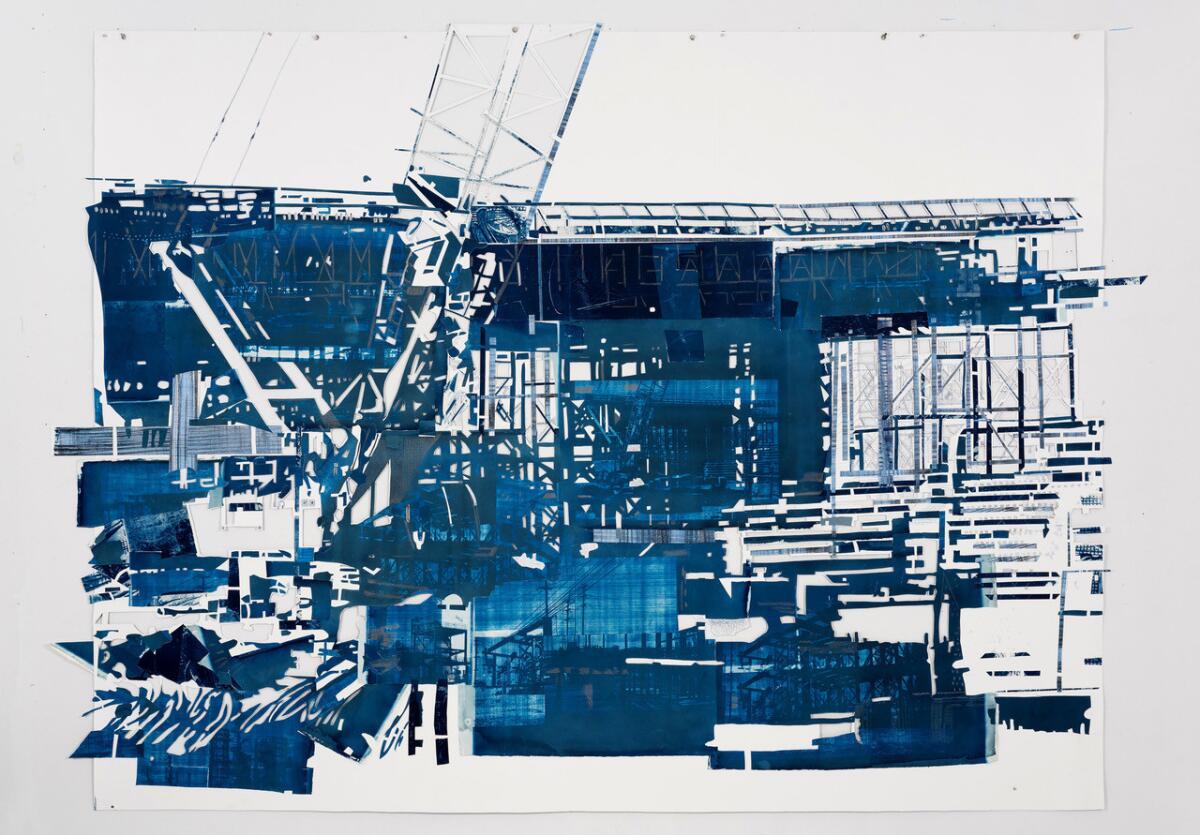
Rick Bartow, “Things You Know but Cannot Explain,” at the Autry Museum of the American West. This is the first comprehensive exhibition devoted to the late Oregon-born painter, a member of the Mad River band of Wiyot. Bartow developed a career as an artist later in life — after his service in the Vietnam War and a period contending with PTSD. On canvas, he found inspiration, drawing from historic and contemporary European and Native American artistic traditions to create a fusion of something new: haunting and totemic images of creatures who channel grief and frailty. Through Jan. 6. 4700 Western Heritage Way, Griffith Park, Los Angeles, theautry.org.
Adrian Piper, “Concepts and Intuitions, 1965-2016,” at the Hammer Museum. This is the most comprehensive exhibition devoted to the career of the conceptual artist, whose multimedia work has served as an ongoing examination of issues of gender, race, identity and those myriad states in between. Over the course of the exhibition, some of Piper’s performances will be staged in the galleries, such as “The Humming Room,” which demands that people hum a tune before being allowed to traverse the room. Featuring 270 works from both public and private collections, the show represents an important consideration of the work of a highly influential American artist. Through Jan. 6. 10899 Wilshire Blvd., Westwood, Los Angeles, hammer.ucla.edu.
John Sonsini, “Daywork: Portraits,” at the Long Beach Museum of Art. In his work, Los Angeles artist Sonsini has been recording the presence of day laborers in the city. This is the first comprehensive exhibition of his work. Through Jan. 6. 2300 E. Ocean Blvd., Long Beach, lbma.org.
Merion Estes, “Unnatural Disasters,” at the Craft & Folk Art Museum. Estes is known for producing bright, richly collaged paintings that take on landscape as well as larger concerns about climate and environment. The survey of her career at CAFAM gathers works from a 20-year period. Raised in Southern California, Estes came from a generation of artists who emerged from the Woman’s Building and is closely connected with the Pattern and Decoration movement of the ’70s and ’80s. In a separate exhibition at the museum, Sherin Guirguis is showing works inspired by the life and work of the late Egyptian poet and writer Doria Shafik, pieces that draw upon important architectural sights, works and actions. Through Jan. 6. 5814 Wilshire Blvd., Mid-Wilshire, Los Angeles, cafam.org.
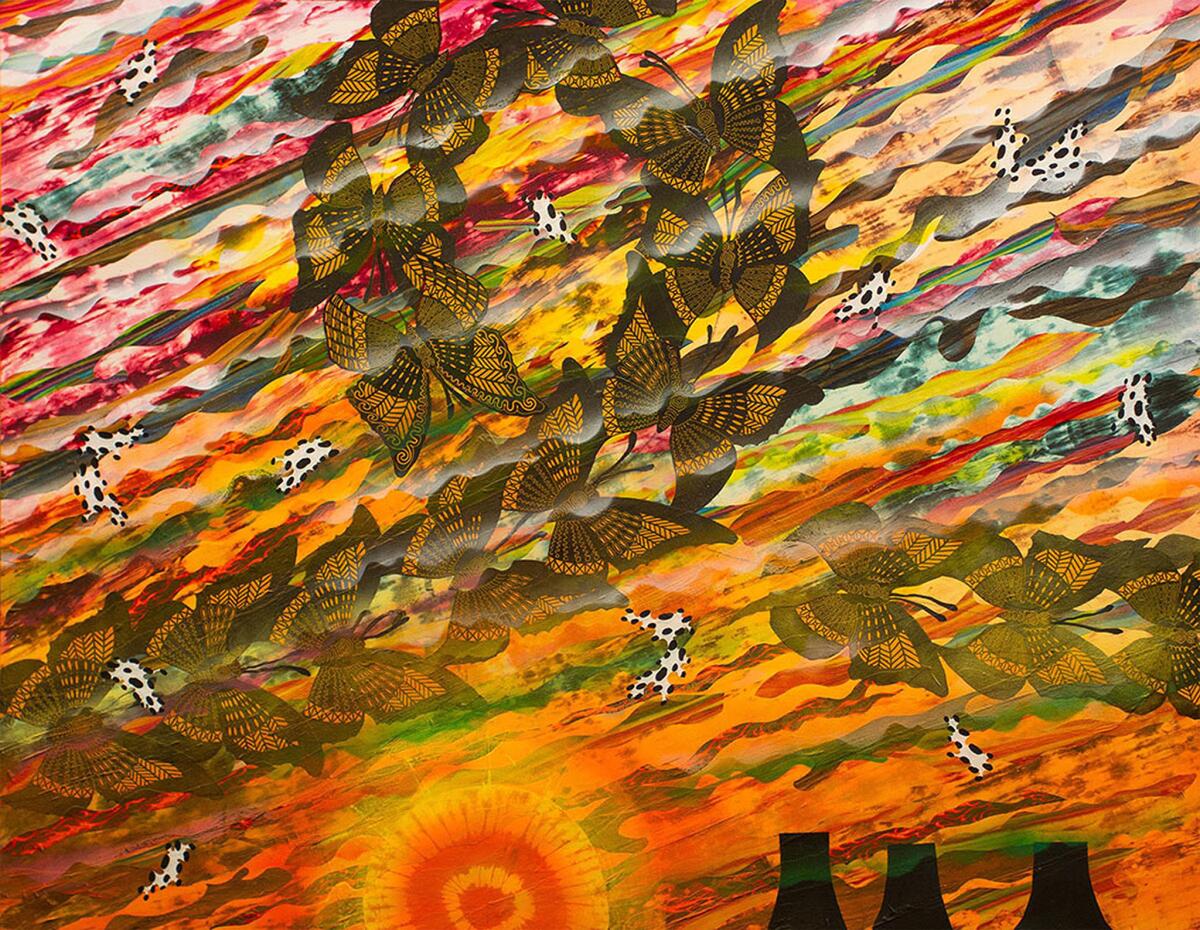
“Life in this Ocean,” at the Annenberg Community Beach House. A four-woman show featuring Donna Bates, Deirdre Sullivan Beeman, Lena Rushing and Kathy Taslitz explores archetypes of the female. Through Jan. 7. 415 Pacific Coast Highway, Santa Monica, lifeinthisocean.com and annenbergbeachhouse.com.
“La Reina de Los Angeles,” at the Sturt Haaga Gallery at Descanso Gardens. Works by an array of Los Angeles-based artists, including Michael Parker, Judy Baca, Galia Linn and Carolina Caycedo, will look at the relationship between people and water in Los Angeles and beyond. Through Jan. 13. 1418 Descanso Drive, La Cañada Flintridge, descansogardens.org.
“War of Nerves: Psychological Landscapes of the Cold War,” at Wende Museum. The Cold War wasn’t just about the hardware (a.k.a. the weapons), it was also about culture. And this exhibition looks at the ways in which the fear of nuclear devastation manifested itself in art and design — down to the toys that children played with. Through Jan. 13. 10808 Culver Blvd., Culver City, wendemuseum.org.
“AxS Festival: City as Wunderkammer,” in locations in Pasadena and surrounding communities. Inspired by the idea of the cabinet of curiosities, this year’s AxS festival, organized by Fulcrum Arts, dwells in the world of art and science. The festival, which features exhibitions and events around Pasadena and the Pomona Valley, will have shows devoted to ceramics (Shumei Hall Gallery), video game art (at And/Or Gallery) and acoustic devices connected with protest (Pitzer College Galleries). Check the website for times and locations; some exhibitions will run through Jan.13. axsfestival.org.
Guadalupe Rosales, “Echoes of a Collective Memory,” at the Vincent Price Art Museum. For years, the Los Angeles artist has been building an archive of ephemera related to Chicano youth culture: studio portraits, informal snapshots, flyers, magazines, mixtapes and other objects. In her first solo museum show, she is employing these in installations that examine the both the intimate and public ways in which SoCal youth have historically connected over fashion, music, cruising, raves and backyard parties. The exhibition will include video, collages and an altar to the memory of a cousin lost to gang violence. Through Jan. 19. East Los Angeles College, 1301 Cesar Chavez Ave., Monterey Park, vincentpriceartmuseum.org.
Nina Chanel Abney, “Royal Flush,” at the California African American Museum. In bright canvases that fuse elements of pop, figuration and bold graphic forms, Abney creates visual narratives that explore aspects of contemporary life, including race, identity and sexuality. Through Jan. 20. 600 State Drive, Exposition Park, Los Angeles, caamuseum.org.

“California Bound: Slavery on the New Frontier, 1848-1865,” at the California African American Museum. The Fugitive Slave Act of 1850 required that escaped slaves be returned to their masters — even if those slaves were in states in which slavery was not legal. In that same year, California joined the union. California was not a slave state, but it enforced the law — albeit erratically. Employing photographs, historical documents and other ephemera, this exhibition examines California’s history in connection with slavery. Through Jan. 21. 600 State Dr., Exposition Park, Los Angeles, caamuseum.org.
“Architects of a Golden Age: Highlights from the Huntington’s Southern California Architecture Collection” at the Huntington Library. Drawn from the museum’s collection of 20th-century architectural drawings, this exhibition features a series of elegant renderings from the 1920s and ’30s of some of L.A.’s most significant buildings, including Union Station, the Mayan Theater and the Stock Exchange Building. Through Jan. 21, huntington.org.
Cara Romero, “Matriarchs,” at the El Segundo Museum of Art. A group show organized by indigenous curators — Kristen Dorsey (Chickasaw Nation) and Jaclyn Roessel (Diné) — features work by a dozen indigenous women artists representing 14 indigenous communities covering themes such as gender, environmental activism and violence against women in a range of art media, including painting, fashion, metalwork, photography and installation. Through Jan. 26. 208 Main St. El Segundo, esmoa.org.
“The Renaissance Nude,” at the Getty Museum. How did the nude obtain its important perch in Western art history? An exhibition at the Getty aims to give us a gander with a sprawling exhibition of more than 100 works — including painting, sculpture, drawings and illuminated manuscripts — that explore the centers most often associated with the Renaissance nude and how the body was employed in a range of cultural contexts, including Christian culture, art theory and more intimate concerns. The show will include an array of works by figures such as Titian, Michelangelo, Giovanni Bellini and Lucas Cranach the Elder, among many others. This is one not to miss. Through Jan. 27. 1200 Getty Center Dr., Brentwood, Los Angeles, getty.edu.

Sandy Rodriguez, “Codex Rodriguez-Mondragón,” at the Riverside Art Museum. Inspired by Bernardino de Sahagún’s 16th century codex, known as the Florentine Codex, a richly detailed report on colonial life in the Americas otherwise, the Los Angeles artist has created a series of paintings that document the landscape and politics of our era on amate, a handmade paper from Mexico. For paint, she employs indigenous, plant-based inks that she fabricates herself. Like colonial documents, which were often full of invention and fantasy, her hallucinatory maps also contend with issues of force and subjugation — in this case, the deportations and child-separation cases affecting contemporary Latin American immigrants. Through Jan. 27. 3425 Mission Inn Ave., Riverside, riversideartmuseum.org.
Rosa Loy, “So Near and Yet So Far,” at Kohn Gallery. Loy, one of the few women associated with Germany’s New Leipzig School (a surreal take on figurative painting that emerged in the wake of the country’s reunification), is having her second solo show at the gallery. On view are works that draw from medieval imagery, fairy tales, mythology and the Wagnerian — quite appropriately, since Loy and her husband, painter Neo Rauch, worked on costumes and set design for the production of “Lohengrin” at the Bayreuth Festival. Through January. 1227 N. Highland Ave., Hollywood, kohngallery.com.
B. Wurtz, “This Has No Name,” at the Institute of Contemporary Art Los Angeles. Is it possible to riff on minimalism and detritus art in a single sculpture? B. Wurtz proves that it is. The artist is known for earnestly odd works that employ take-out tins, product packaging, socks and bits of wood as building blocks for assemblages that elevate the mundane while putting a pin to the balloon of austerity. Do not miss the video of the Bic pen. Through Feb. 3. 1717 E. 7th St., downtown Los Angeles, theicala.org.
“Being Here With You / Estando Aquí Contigo: 42 Artists From San Diego and Tijuana,” at the Museum of Contemporary Art San Diego. A group show brings together work by 42 artists and collectives living and working in San Diego and Tijuana and shows the cultural dialogues that have occurred across one of the world’s hardest political lines. The show’s title is a reference to the region’s musical history — taken from lyrics from the tune “Angel Baby,” performed by Rosie and the Originals, a teenage band from National City. Through Feb. 3. 1100 Kettner Blvd., San Diego, mcasd.org.

“Ink,” at the Museum of Latin American Art. This exhibition brings together various histories of tattooing in L.A. — including those inspired by military culture, Chicano tattooing and other historic forms. It will be presented alongside works from the permanent collection that connect with the theme of tattooing. Through Feb. 3. 628 Alamitos Ave., Long Beach, molaa.org.
“Art of Three Faiths: A Torah, A Bible, and a Qur’an,” at the Getty Museum. The Getty Museum acquired the Rothschild Pentateuch, a manuscript of the first five books of the Torah from the 13th century. It is now putting this rare document on display with other examples of illuminated sacred texts, including a Christian Bible and a Koran. Through Feb. 3. 1200 Getty Center Drive, Brentwood, Los Angeles, getty.edu.
“La Raza,” at the Autry Museum of the American West. In its day, the civil rights publication La Raza, which was based in Lincoln Heights, served as a bible for the Chicano movement, covering protest, policy and everyday life for the Mexican American communities of Los Angeles. Over the years, the paper amassed an archive of 25,000 images, recently digitized by the Chicano Studies Research Center. Many are now on view as part of this PST: LA/LA show at the Autry — and in a time of political strife surrounding the issues of civil rights, this exhibition couldn’t be more timely. Through Feb. 10. 4700 Western Heritage Way, Griffith Park, Los Angeles, theautry.org
“Regeneración: Three Generations of Revolutionary Ideology,” at the Vincent Price Art Museum. A group exhibition examines three movements, from three different eras, that served as key moments for the exchange of activist and revolutionary ideas between the U.S. and Mexico. All of this is centered on “regeneración” — or regeneration — a term first employed by the Flores Magon brothers during the era of the Mexican Revolution. It was adopted by Chicano activist circles in the 1970s, for the magazine “Regeneración,” and the ’90s experimental space Regeneración/Popular Resource Center of Highland Park. Through Feb. 16. 1301 Cesar Chavez Ave. Monterey Park, vincentpriceartmuseum.org.
Deana Lawson, “Planes,” at the Underground Museum. Lawson is known for portraits that feature black men and women in regal poses, often in humble domestic settings. In the past, she has described her subjects as the “displaced kings and queens of the diaspora.” This show gathers examples of her recent work. Through Feb. 17. 3508 W. Washington Blvd., Arlington Heights, Los Angeles, theunderground-museum.org.

Robert Pruitt, “Devotion,” at the California African American Museum. Pruitt paints people in ways that capture their spiritual aspects. In his first major museum show in L.A., he uses this framework to explore aspects of devotion in his own life and upbringing. Through Feb. 17. 600 State Drive, Exposition Park, Los Angeles, caamuseum.org.
“The Archival Impulse: 40 Years at LACE,” at Los Angeles Contemporary Exhibitions. LACE, the historic Los Angeles art spot that gave key shows to Mike Kelley and groups such as Survival Research Laboratories in the ’80s, is turning 40 — and to mark the occasion, the organization has been poking around its metaphorical attic (aka its archive) to see what it might turn up. This show gathers elements from that archive as well as video works by a range of Los Angeles artists, including Jim Shaw, Susan Mogul and Reza Abdoh. Through Feb. 24. 6522 Hollywood Blvd., Hollywood, welcometolace.org.
Carolina Caycedo and Mario Ybarra Jr., “Rituals of Labor and Engagement,” at the Huntington Library, Art Collections and Botanical Garden. For three years running, the Huntington has invited contemporary artists to react to and install work on their grounds. For this go-around, the museum has teamed up with the Vincent Price Art Museum to offer a residency program to two artists — Caycedo and Ybarra — who have spent several months studying the Huntington’s collections and produced work inspired by the collection. In particular, around issues of labor within the context of the collection, but also the site of the Huntington itself. Through Feb. 25. 1151 Oxford Road, San Marino, huntington.org.
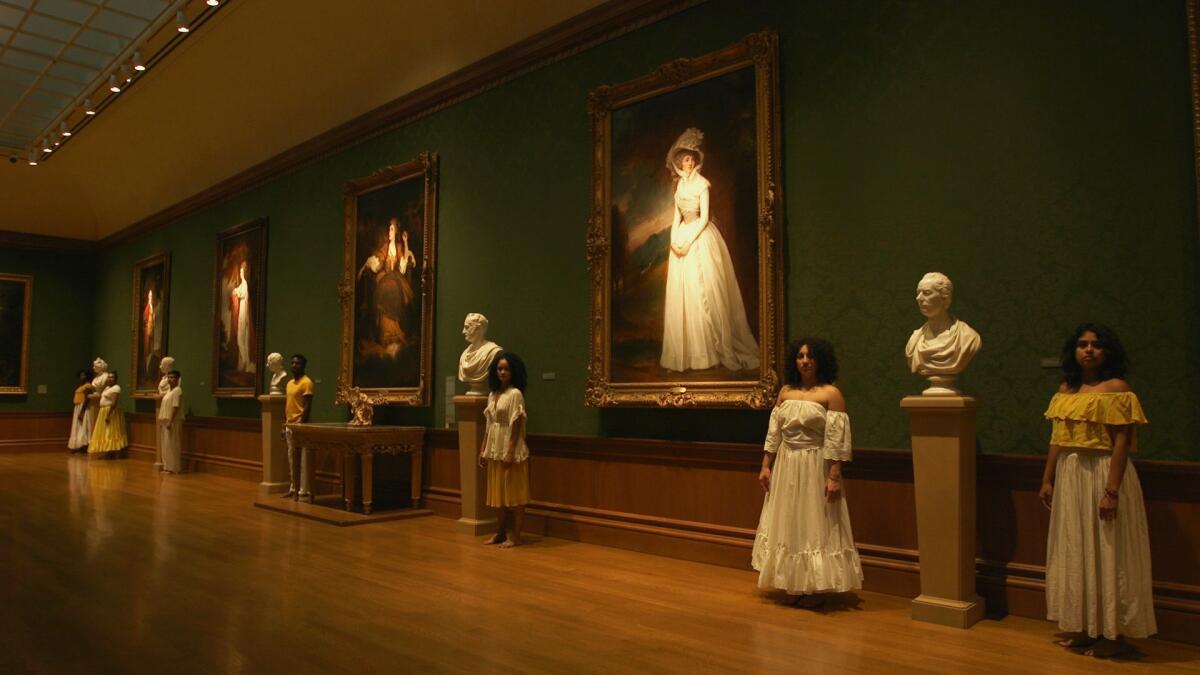
“A Journey That Wasn’t,” at the Broad museum. A group show drawn from the museum’s collection features work by more than 20 artists whose work dwells on the concept of time and its passage. This includes pieces by Ed Ruscha, Glenn Ligon and Sharon Lockhart and will feature the return of the video installation “The Visitors,” by Ragnar Kjartansson, a charming multi-channel installation that features a group of musicians playing a collective piece while seated in rooms of a decaying mansion. In other words: a welcome break from the news. Through February. 221 S. Grand Ave., downtown Los Angeles, thebroad.org.
Ai Weiwei, “Life Cycle,” at the Marciano Art Foundation. This represents the first significant institutional exhibition for the Chinese dissident artist in Los Angeles and will include iconic works such as “Sunflower Seeds,” Ai’s 2010 installation of thousands of ceramic pieces meticulously hand-painted to resemble seeds, as well as new works that contend with Europe’s ongoing refugee crisis. Through March 3. 4357 Wilshire Blvd., Windsor Square, Los Angeles, marcianoartfoundation.org.
“The Notion of Family” at the California African American Museum. A group exhibition spanning two centuries looks at depictions of the African American family over time — in intimate domestic settings, but also in gatherings both private and public. This includes early photographs, paintings, drawings and other works by a variety of high-profile artists, including Jacob Lawrence, Miguel Covarrubias, Carrie Mae Weems, John Biggers and others. Through March 3. 600 State Drive, Exposition Park, Los Angeles, caamuseum.org.

“One Day at a Time: Manny Farber and Termite Art” at the Museum of Contemporary Art. In 1962, artist and critic Manny Farber wrote an essay titled “White Elephant Art vs. Termite Art,” which picks apart the excesses of market-oriented “white elephant” art and celebrates “termite art,” made on a smaller, more personal scale and reflecting deep commitment and attention. This exhibition will feature more than 100 works by 30 artists inspired by Farber’s idea of art as being about “observing and being in the world.” I assume this means no sculptures by Jeff Koons. Through March 11. 250 S. Grand Ave., downtown Los Angeles, moca.org.
Rafael Cardenas, “Landscape and Land Dwellers: Photography of Place,” at La Plaza de Cultura y Artes. Cardenas is widely known for his street photography. In this new exhibition he brings together a series of portraits and landscape images that find the connection between people and place in Los Angeles. Through March 25. 501 N. Main St., downtown Los Angeles, lapca.org.
“Laura Owens” and “Zoe Leonard: Survey,” and at the Museum of Contemporary Art Los Angeles. The museum’s Geffen branch is opening a pair of exhibitions: the paintings retrospective of Los Angeles painter Laura Owens, whose groundbreaking work reinvigorated painting with canvases that toy with abstraction, figuration and the picture plane itself, as well as Leonard, the New York-born conceptual artist whose work has included visceral sculpture (fruit peeled and sewn back together), photography (both her own and vernacular) and poetry (her famous poem, “I Want a President”). Through March 25. Geffen Contemporary, 152 N. Central Ave., downtown Los Angeles, moca.org.

Merce Cunningham, “Clouds and Screens” at the Los Angeles County Museum of Art. This exhibition pairs well with LACMA’s show on Robert Rauschenberg since Cunningham, the famed choreographer, was a good pal and collaborator. This show delves just into that: Cunningham’s myriad collaborations with artists who helped him create costumes, film, music and sets. Through March 31. 5905 Wilshire Blvd., Mid-Wilshire, Los Angeles, lacma.org.
“West of Modernism: California Graphic Design, 1975-1995,” at the Los Angeles County Museum of Art. A show drawn from LACMA’s growing collection of design objects looks at a transformative moment in graphic design, when individual designers were becoming more high-profile, the home computer was shaking up the ways in which design could be produced and images were becoming increasingly fragmented and layered. Through April 21. 5905 Wilshire Blvd., Mid-Wilshire, Los Angeles, lacma.org.
“Unsettled,” at the Palm Springs Art Museum. A group show features work by more than 75 artists living or working in the “Greater West,” encompassing a region from Alaska to Central America, as well as a diverse range of media, including painting, sculpture, photography and performance. There will even be Twitter poems. Through April 30. 101 Museum Drive, Palm Springs, psmuseum.org.
Rauschenberg: The 1/4 Mile, at the Los Angeles County Museum of Art. The obsessive print maker Robert Rauschenberg was known for making obsessive works, including a monumental 190-panel installation that when assembled reaches approximately a quarter-mile in length. The show includes additional elements that includes ambient sound. Through June 9. 5905 Wilshire Blvd., Mid-Wilshire, Los Angeles, lacma.org.
“Auto-Didact: The Juxtapoz School,” at the Petersen Automotive Museum. Custom car culture has had a far-reaching influence on American culture in general, including art, where representation, design and finishes have all had an influence. The show features works by Von Dutch, Sandow Birk, Gary Panter, Mister Cartoon, Robert Williams, Suzanne Williams and many others. Through June 2019. 6060 Wilshire Blvd., Mid-Wilshire, Los Angeles, petersen.org.
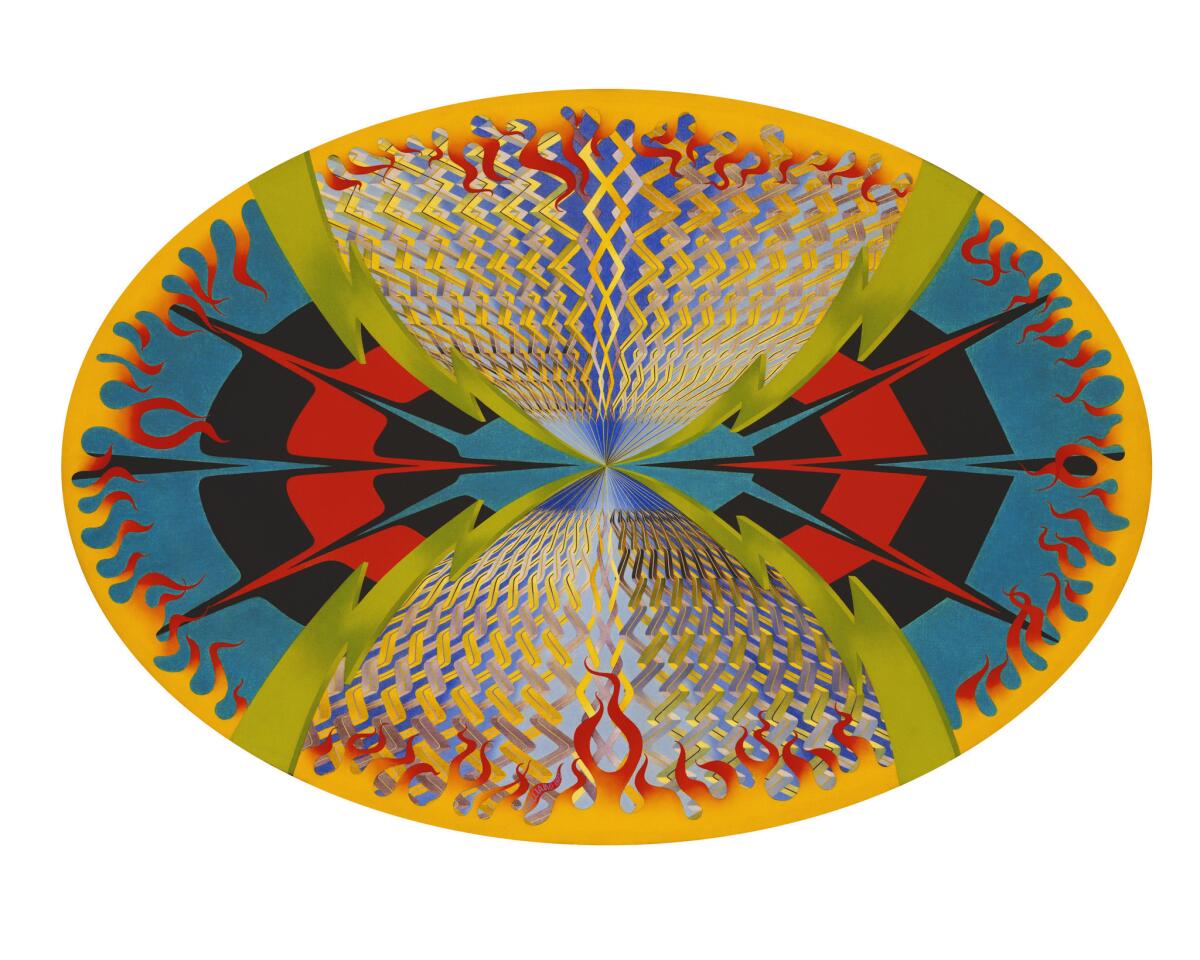
“L.A. Communities Through the Eyes of Artists,” in the Passageway Gallery at Union Station. For 15 years, L.A.’s principal train station has been showcasing work that reveals the city through the eyes of its artists. This year, it is showing a series of newly commissioned pieces — including Shizu Saldamando’s depiction of Little Tokyo, Sam Pace on Leimert Park and Artemio Rodriguez on East L.A. On long-term view; no closing date set. Union Station, 800 N. Alameda St., downtown Los Angeles, metro.net.
Daniel Hawkins, “Desert Lighthouse.” The Los Angeles-based artist is obsessed with producing works that toy with ideas of grandiosity, failure and gestures that border on the Sisyphean. (One of his goals as an artist is to ultimately build a scale replica of the Hoover Dam.) Now, Hawkins has installed a 50-foot tall, fully functioning lighthouse in the Mojave Desert in the vicinity of Barstow. The piece even features a light to guide travelers through this rugged landscape. Directions and coordinates can be found on the website. On long-term view, Hinkley, Calif., desertlighthouse.org.
Sign up for our weekly Essential Arts & Culture newsletter »
Twitter: @cmonstah
The biggest entertainment stories
Get our big stories about Hollywood, film, television, music, arts, culture and more right in your inbox as soon as they publish.
You may occasionally receive promotional content from the Los Angeles Times.








